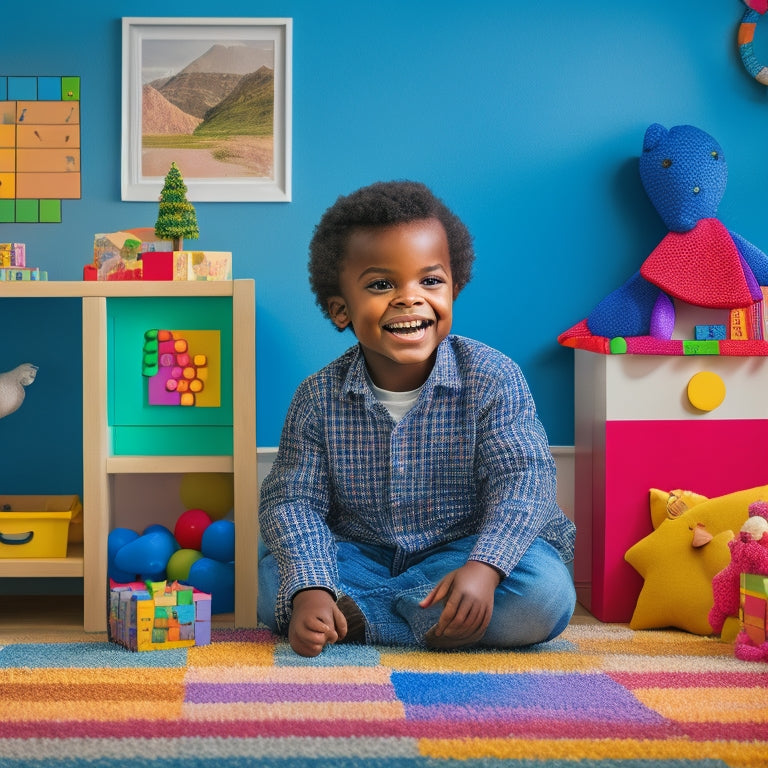
Boost Behavior With Positive Discipline Approach
Share
Positive discipline is a transformative approach that boosts behavior by fostering a nurturing environment, promoting healthy emotional regulation, and teaching essential social skills. By shifting focus from criticism and punishment to empathy and understanding, parents can encourage exploration, learning, and growth. This approach builds resilience, confidence, and a strong parent-child relationship, leading to better behavior and overall well-being. By understanding the harm of negative reinforcement and implementing effective discipline techniques, parents can create a supportive environment that nurtures emotional intelligence and guides children towards responsible behavior, and there's more to discover about this powerful approach.
Key Takeaways
• Positive discipline fosters healthy development, emotional regulation, and a positive self-image, leading to better behavior in children.
• By focusing on teaching and guiding, parents can encourage empathy, resilience, and essential social skills in their kids.
• Clear boundaries and consequences help children understand expectations and develop self-awareness, leading to improved behavior.
• Modeling desired behavior, praising progress, and validating emotions helps build confidence and promotes positive behavior in children.
• A supportive environment that prioritizes mutual respect, open communication, and trust helps children develop self-regulation skills and better behavior.
The Harm of Negative Reinforcement
When parents resort to putdowns, they unwittingly sow the seeds of low self-esteem, negative self-image, and a damaged parent-child relationship in their children. The impact of criticism can be devastating, leading to internalized negative messages, increased stress, and anxiety.
On the other hand, encouragement has numerous benefits, fostering a positive self-image, confidence, and resilience. By adopting a positive discipline approach, parents can promote healthy development, self-awareness, and emotional regulation in their children.
Fostering a Positive Environment
By adopting a positive discipline approach, parents can create a nurturing environment that fosters a sense of safety, security, and belonging, allowing their children to feel comfortable exploring, learning, and growing.
This environment is built on mutual respect, empathy, and understanding, creating positivity that permeates every interaction. Parents can achieve this by being approachable, listening actively, and validating their child's emotions. By doing so, they build trust, which is essential for a healthy parent-child relationship.
A positive environment encourages children to take risks, make mistakes, and learn from them, promoting resilience and confidence. As a result, children develop a strong sense of self-worth, becoming more receptive to guidance and direction.
Effective Discipline Techniques
Effective discipline techniques involve adopting a proactive approach that focuses on teaching and guiding children, rather than simply punishing or reacting to misbehavior. By doing so, parents can encourage empathy and understanding in their children, helping them develop essential social skills.
Building resilience is another key aspect of effective discipline, as it allows children to learn from their mistakes and bounce back from setbacks. This approach also helps parents establish clear boundaries and consequences while maintaining a positive and loving relationship with their child.
Nurturing Better Behavior
Nurturing better behavior in children requires a deep understanding of their emotional needs and a willingness to model the behavior you wish to see in them. By doing so, you create a supportive environment that fosters growth and development.
Here are three ways to nurture better behavior in your child:
-
Building confidence: Encourage your child to take calculated risks and praise their efforts, not just their achievements. This helps build resilience and confidence in their abilities.
-
Encouraging growth: Focus on progress, not perfection. Celebrate small victories and acknowledge efforts towards improvement.
-
Fostering self-awareness: Help your child identify and understand their emotions, and teach them healthy ways to express and manage their feelings.
Guidance for Positive Parenting
Guiding children towards positive behavior requires a thoughtful and intentional approach that prioritizes mutual respect, open communication, and emotional validation. This approach helps build trust and encourages growth in children. By fostering a positive parent-child relationship, parents can create an environment conducive to learning and development.
| Positive Parenting Strategies | Benefits |
| Encourage open communication | Builds trust and understanding |
| Validate emotions and feelings | Encourages emotional regulation |
| Set clear boundaries and consequences | Promotes responsibility and accountability |
Frequently Asked Questions
How Do I Avoid Being Too Permissive With My Child?
"A million times a day, parents struggle to find the perfect balance between nurturing and discipline. To avoid being too permissive, set clear expectations and maintain consistent boundaries, providing a sense of security and structure for your child to thrive."
What if My Child's Behavior Doesn't Improve With Positive Discipline?
When behavior doesn't improve, identify underlying Behavior Triggers and address Consistency Challenges. Reflect on your approach, seeking support if needed, to guarantee a tailored and effective positive discipline strategy that fosters meaningful change.
Can I Still Set Boundaries While Being a Positive Parent?
Establishing boundaries as a positive parent is essential, as it provides a sense of security and structure for children. Authority figures can set clear expectations with consistent messaging, promoting healthy development and respect for boundaries.
How Do I Handle Public Tantrums With a Positive Discipline Approach?
When managing public tantrums, it's important to recognize that tantrum triggers often stem from feelings of frustration and overwhelm. Employ calm strategies such as empathetic listening, deep breathing, and gentle redirection to de-escalate the situation and promote a sense of security and understanding.
Is It Too Late to Switch to Positive Discipline if My Child Is Already a Teenager?
When moving towards positive discipline with a teenager, acknowledge the potential for teenage rebellion and parental guilt. Start by apologizing for past mistakes, and work together to establish new boundaries and expectations, fostering open communication and trust.
Related Posts
-

Industrial Bathroom Cabinet With Vintage Faucets
You're creating a unique industrial bathroom cabinet with vintage faucets that exudes rustic charm and sophistication...
-

Momtrepreneurs: Master Organization for Success
As a busy momtrepreneur, I've learned that mastering organization is the key to unleashing my full potential. To achi...
-

Mastering Project Management Organization for Success
You know that mastering project management organization is essential for success, but it requires a strategic approac...


